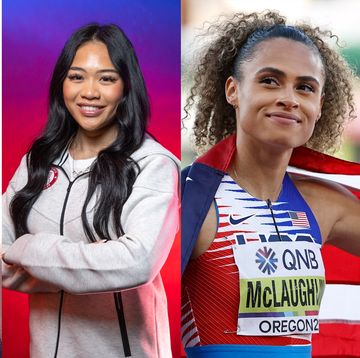A recent cover shoot and story in Vogue featuring supermodel Gigi Hadid and pop star Zayn Malik brought the term "gender fluidity" into the national conversation. The couple told Vogue that they often shop each other's closets, and say that their style is "not about gender." But the term "gender fluid" actually implies much more than that.
According to the Human Rights Campaign, “gender fluid” is used to describe a person “who does not identify with a single fixed gender; of or relating to a person having or expressing a fluid or unfixed gender identity." (The term was added to the Oxford English Dictionary in 2016.) People who are gender fluid “may define their gender as falling somewhere in between, both combined, or a mixture of these two binary genders that may flux from day to day,” says GLAAD spokesperson MJ Okma. People who are gender fluid may prefer the pronouns “they” and “them” instead of “he” or “she,” but that varies by individual preference.
RELATED: 5 Transgender Celebrities Who Are Breaking Barriers And Making History
Gender fluidity is "under the same umbrella" as being transgender, but is still distinctly different, says Matthew Oransky, Ph.D., director of the Psychology Training Program at Mount Sinai Adolescent Health Center. "Being gender fluid means that you don’t feel as though your gender is fixed," he says, adding that it can be distressing for gender fluid people when others try to force them to pick a gender. They often feel gender dysphoria, Oransky says—which is distress a person experiences as a result of the gender they were assigned at birth.
Three percent of millennials identify as gender fluid according to a 2017 report from GLAAD, including college student and GLAAD Campus Ambassador L. Juliett. And L. Juliett stresses that gender fluidity isn’t a fad. “To me, gender fluidity is an important term used to describe my ability to identify outside of the gender binary. My gender fluidity is not a millennial culture craze, nor an art pop fashion statement,” they say. “It is my journey in finding myself in a world that demanded I fit in a box that didn’t fit me.”
SIGN UP FOR WOMEN'S HEALTH'S NEWSLETTER, SO THIS HAPPENED, TO GET THE DAY'S TRENDING STORIES AND HEALTH STUDIES.
Oransky feels that mislabeling celebrities as gender fluid due to their style or beauty choices makes it seem "faddish" rather than a real identity. "This could have the danger of spreading misinformation and trivializing people's real experiences," he says. Oransky has worked with hundreds of transgender and gender non-conforming teens, and says that the ones who identify as gender fluid can have an even more difficult time than transgender teens in getting understanding from their parents and loved ones. And that, he says, can be damaging.
That's why Oransky says it's so important for people to understand that gender fluidity is real and not a made-up thing as, unfortunately, some people believe. As the term implies, the experience of gender fluidity really varies. "It’s important to remember that there is no one definition of gender fluidity that encompasses everyone’s experience of gender that personally identifies as gender fluid," Okama says. For more information on gender fluidity, check out GLAAD's ally guide.













